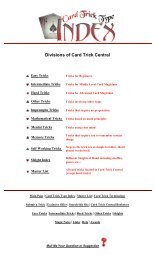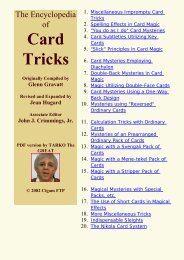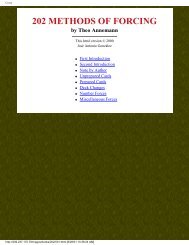Card Manipulations No. 4 By Jean Hugard - Umclidet
Card Manipulations No. 4 By Jean Hugard - Umclidet
Card Manipulations No. 4 By Jean Hugard - Umclidet
Create successful ePaper yourself
Turn your PDF publications into a flip-book with our unique Google optimized e-Paper software.
<strong>Card</strong> <strong>Manipulations</strong> <strong>No</strong>. 4<br />
<strong>Jean</strong> <strong>Hugard</strong><br />
Next | Previous | Contents<br />
The Expanding and Diminishing <strong>Card</strong>s<br />
Effect: The cards are expanded to nearly twice their usual size and then diminished by<br />
several stages until they vanish completely.<br />
Requirements: A stripper pack of Steamboats, or other cards with backs of a solid pattern,<br />
i.e. without white margins; stripped a little more deeply than usual. A giant card and a<br />
miniature card with similar backs, and a small stand against which to display these cards<br />
upright.<br />
Preparation: Arrange thirty-two cards in pairs, taking cards that most resemble each other,<br />
for instance, the kings and jacks, nines and tens, and sevens and eights of each suit. Turn<br />
each alternate card round so that the narrow end of the first card will point outwards and<br />
the narrow end of the second card inwards. Fig. 28.<br />
Thus arranged if the ends of the pack are pulled outwards<br />
and the cards fanned, the similarity of the alternate cards<br />
will give it the appearance of having been elongated. One<br />
odd card must be put on the top and the ace of diamonds<br />
must be on the bottom with the Three of Diamonds<br />
behind it. If you now take the pack in your left hand and<br />
with the right strip the reversed cards out for about threequarters<br />
of their length you will find that by pressing<br />
tightly on the cards at the top and bottom of the packet<br />
held by the left hand, you can safely fan the elongated<br />
pack and still retain the protruding cards in position.<br />
This order is retained throughout the trick, and the reason for an Ace being put at the<br />
bottom is that the illusion of the cards being diminished would be spoiled by the<br />
disproportionate amount of the pattern being visible at the various stages if any other card<br />
faced the audience. Thirty-two cards only are used because the full pack is too bulky for<br />
neat handling in the manipulations, unless indeed, you are fortunate enough to have a very<br />
large hand. Place an extra card, any card, in front of the Ace of Diamonds, for a reason to<br />
be given later.<br />
The giant card you fix in a paper clip sewn on the inside of the vest in such a position that<br />
when the lower end of the card is pushed into the dip, the upper end will be just out of sight<br />
at the top of the vest. The miniature card you fix in a similar manner under the lapel of the<br />
coat on the right hand side.<br />
The Working: Let us suppose that you have worked some such trick as the "<strong>Card</strong>s up the<br />
Sleeve," or the "Three <strong>Card</strong>s Across," remark that the explanation of the mystery is that the<br />
cards are made of rubber and that by pulling and squeezing them, they can be made any<br />
size you please. Offer to show how it is done and pick up your arranged stripper deck. You<br />
will, of course, be careful to use a pack with the same backs in your preceding trick.<br />
"You see the cards are the ordinary size," you say as you take off the odd card from the<br />
bottom. "I will put one here so that you can fully appreciate the changes in the size of the<br />
cards." Place the card upright against the stand on the table. Then spread the pack fanwise<br />
in the left hand with the backs to the spectators, you have your right side to the front. Fig.<br />
29.<br />
"Suppose I want the cards a little bigger. I simply pull them like this." Take the outer end<br />
of the deck in your right hand and strip the cards out about an inch. Spread the cards<br />
fanwise with the right thumb and exhibit the cards, thus enlarged, in the left hand with their<br />
backs to the front. Fig. 30. They must be firmly held between the thumb, pressing on the<br />
backs, and the fingers on the faces of the cards. Keep your left hand in motion, as if to<br />
show the enlarged cards to everyone, the point of junction between the two packets will not<br />
then be visible.<br />
Close the fan sharply with the right hand, then strip the packets a little farther apart, this<br />
time leaving only about three-quarters of an inch of the upper packet interweaved in the<br />
lower cards. Still standing with your right side to the spectators, spread the pack in as wide<br />
a fan as possible, being careful to press down firmly with the left thumb, holding the<br />
projecting cards in position. Fig. 31.<br />
Keep the hand moving as before, then turn to face the audience direct. With the right hand<br />
at. the top of the fan make a pretense of adjusting the cards which now have their faces to<br />
the front. Slip the right first finger and thumb behind the top of the fanned cards and at the<br />
same time bring the left hand back until the top of the fan is just above the opening of the<br />
vest, as if to better display the increased size of the cards. With the tips of your right thumb<br />
and forefinger seize the giant card by its upper end and, raising both hands slightly, draw it<br />
from the vest behind the fan. To facilitate this steal you should have the top button of your<br />
vest unfastened.<br />
Slide the right hand top corner of the giant card between the two of the cards in the middle<br />
of the fan, then slowly draw it out. If the card has the same pattern as the pack, show it<br />
back and front; if not, then show the face of the card only and stand it on the table beside<br />
the card already there.<br />
Close the fan as you say, "If I want to reduce the cards I simply squeeze them so." Cover<br />
the pack with your right hand and with a pretense of squeezing them vigorously, push the<br />
projecting cards down until a little less than half their length protrudes. Turn to the left and<br />
again spread the cards fanwise, showing their backs and keeping your hand in motion as<br />
before. (Fig. 30.)<br />
"Another squeeze and they are back to their original Size." Bring the fight hand over the<br />
cards and push the projecting cards flush with the lower packet, then spread them and hold<br />
the squared up pack close to the giant card to show the reduction in size. (Fig. 29.)<br />
"It is possible to reduce them to half the size." Bring the right hand over the pack. Make a<br />
pretense of squeezing the pack vigorously and then strike it with the half closed hand. As<br />
you do this turn to face the front, bringing the back of the left hand towards the spectators.<br />
Hold the pack in such a way that only one-half is visible above the left forefinger. Again<br />
spread the pack fanwise and the cards appear to have been reduced to half their original<br />
size. (Fig. 32.)<br />
"With a little more pressure they can be made smaller still." You close the fan and<br />
squeezing the cards as before, push the pack a little further down in the left hand, allowing<br />
only about half an inch to protrude. Strike them several times with the half closed right<br />
hand. Spread these apparently miniature cards, Fig. 33, and, as if to display them better,<br />
bring the left hand back against the lapel of your coat. In the same way that you secured the<br />
giant card, grip the tiny card concealed there by the tips of the right thumb and first finger,<br />
and bring it out behind the fan. Draw it out from between two of the cards about the middle<br />
of the fan, show it and place it upright against the stand, beside the giant card.<br />
"I can make the cards so very small that they will be scarcely visible. Just a squeeze and a<br />
hard tap, like this, and you can barely see them." At the word "squeeze" palm the pack in<br />
the right hand, instantly raising it about six inches, back of the hand to the front, of course,<br />
and bring it down sharply, striking the tips of the left fingers and thumb. Press the thumb<br />
and fingers together, as if holding the compressed cards with difficulty, close the lower<br />
three fingers of the right hand inwards, bending the palmed pack towards the palm, and<br />
point with the right index finger to the left hand.<br />
Palming the pack will require a little practice ,but if the right positions are taken, there is no<br />
real difficulty in executing the move. To close the fan of the very small cards, place the<br />
right hand, held vertically, against the right side of the fan so that the first joint of the<br />
forefinger touches the top fight hand corner of the fan. Close the spread by moving the<br />
right hand to the left and, the moment the pack is squared, bend the tip of the left first<br />
finger under it and propel the pack into the right hand. The instant it is palmed, raise the<br />
right hand and strike the tips of the left fingers and thumb with the heel of the hand. At the<br />
same moment turn to the left and point to the left hand.<br />
The next move is to change over the pack from the right hand to the left. This is done as<br />
you turn to the right, bringing the left side to the front. The hands are brought together as<br />
you face front and, under cover of their backs, the change over is made, the turn to the right<br />
is continued, the right fingers and thumb being pressed together just as the left fingers and<br />
thumb were a moment before, and the left index finger is extended, pointing at the<br />
supposed tiny cards in the right hand. The transfer takes but the fraction of a second. In<br />
order to spring the pack from the right hand to the left, bend the right second finger, top<br />
joint, in behind it as you bring the right hand to meet the left. The instant the left hand<br />
secures the pack, turn your right hand upwards, palm to the front, and pretend to take the<br />
compressed cards between the tips of the first two fingers and the thumb. You should do<br />
this with an effort, as if taking something that would expand if you did not hold it tightly.<br />
Raise the right hand with the imaginary cards and concentrate your whole attention on it.<br />
"When the cards have been squeezed as small as this," you say, "they can be easily passed<br />
up the sleeve." Snap the fight fingers and open them wide, showing right hand empty. At<br />
once thrust the left hand under your coat, just above the shoulder, and push the pack well<br />
in. Then with the right hand throw your coat open and bring out the cards, holding them at<br />
the tips of the left fingers by their extreme ends, spreading them at the same time into as<br />
big a display as possible.<br />
For the purpose of the trick it is necessary to spread the pack smartly with one movement<br />
of the right thumb across the back. The modern method of fanning the cards, by bending<br />
them as the spread is made, is not suitable.<br />
I cannot too strongly recommend the student to devote the time necessary to master this<br />
most charming of all manipulative feats with cards.<br />
Next | Previous | Contents








